Potrebujeme váš súhlas na využitie jednotlivých dát, aby sa vám okrem iného mohli ukazovať informácie týkajúce sa vašich záujmov. Súhlas udelíte kliknutím na tlačidlo „OK“.
ASTM E2553-07(2013)
Standard Guide for Implementation of a Voluntary Universal Healthcare Identification System (Withdrawn 2022)
Automaticky preložený názov:
Štandardné Príručka pre implementáciu zdravotníckeho identifikačného systému Dobrovoľné Universal
NORMA vydaná dňa 1.3.2013
Informácie o norme:
Označenie normy: ASTM E2553-07(2013)
Poznámka: NEPLATNÁ
Dátum vydania normy: 1.3.2013
Kód tovaru: NS-45587
Počet strán: 14
Približná hmotnosť: 42 g (0.09 libier)
Krajina: Americká technická norma
Kategória: Technické normy ASTM
Kategórie - podobné normy:
Anotácia textu normy ASTM E2553-07(2013) :
Keywords:
ICS Number Code 35.240.80 (IT applications in health care technology)
Doplňujúce informácie
| Significance and Use | ||
|
5.1 This standard describes a proposal to provide unambiguous personal identification for any patient who requests it. In today’s world of specialized healthcare and mobile patients it is typical for clinical information on a single patient to reside in a variety of locations, some using manual data storage techniques, but an increasing number using electronic means. In order for a clinician to provide safe and appropriate clinical care in this environment it is necessary to be able to aggregate appropriate clinical information on a specific patient in order to gain an accurate and comprehensive picture of that patient’s clinical situation. This implies that all information relating to each patient should be identified in a unique manner to facilitate the process of accurately aggregating appropriate information. 5.2 The converse of the need for data aggregation is the patient’s need to protect the privacy of their information. Unless patients are confident that they can avoid inappropriate sharing of clinical information they will not readily share that information with caregivers. Thus, the same system that supports unambiguous linkage of all information concerning a patient must also play a role in protecting the privacy of that information. 5.3 The proposed patient identification system must be able to avoid or overcome the numerous objections that have prevented implementation of a universal patient identification system in the past including issues related to: 5.3.1 Technology—The proposed system must be technically feasible in a manner that promotes scalability, availability, and ease of implementation. 5.3.2 Integration with Existing Systems—To the maximum extent possible the proposed identification system should work seamlessly with existing information systems. 5.3.3 Cost-effectiveness—The proposed system should balance the costs and benefits required to implement a fully functional voluntary universal healthcare identification system. 5.3.4 Political Feasibility—Because many different constituencies have a vested interest in a universal patient identification system, it has been a significant challenge to gain consensus on how to implement such a system. 5.3.5 Gradually Implementable—In order to minimize the impact associated with its implementation, a desirable property of a voluntary universal healthcare identification system is that it be gradually implementable over time. 5.3.6 Acceptable to the General Public—A voluntary universal healthcare identification system must be accepted by the general public as a beneficial, effective and non-threatening capability. 5.4 Experience has shown that a healthcare identification system will only be feasible if it is dedicated exclusively to the needs of healthcare. It is only in this focused environment that it has been possible to create a consistent, feasible, functional, and effective design for such a system. |
||
| 1. Scope | ||
|
1.1 This document describes the implementation principles needed to create a Voluntary Universal Healthcare Identification (VUHID) system. The purpose of this system is to enable unambiguous identification of individuals in order to facilitate the delivery of healthcare. 1.2 The VUHID system should be dedicated exclusively to the needs and functions of healthcare. 1.3 The VUHID system is designed to represent no, or at least minimal, increased risk to healthcare privacy and security. 1.4 The system should be as cost-effective as possible. 1.5 The system must be created and maintained in a way to provide sustained benefit to healthcare. 1.6 The system should be designed and implemented in a manner that ensures that it can operate indefinitely. 1.7 This standard does not purport to address all of the safety concerns, if any, associated with its use. It is the responsibility of the user of this standard to establish appropriate safety and health practices and determine the applicability of regulatory limitations prior to use. |
||
| 2. Referenced Documents | ||
|
Podobné normy:
Historická
1.12.2012
Historická
1.6.2010
Historická
1.3.2013
Historická
1.5.2011
Historická
1.5.2011
Historická
15.12.2013


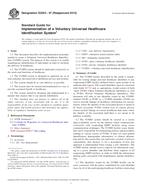
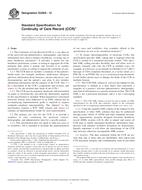 ASTM E2369-12
ASTM E2369-12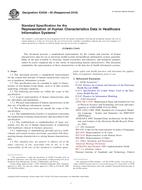 ASTM E2436-05(2010)..
ASTM E2436-05(2010)..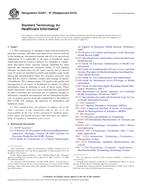 ASTM E2457-07(2013)..
ASTM E2457-07(2013)..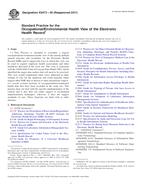 ASTM E2473-05(2011)..
ASTM E2473-05(2011)..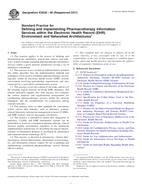 ASTM E2538-06(2011)..
ASTM E2538-06(2011)..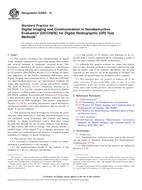 ASTM E2699-13
ASTM E2699-13
 Cookies
Cookies
